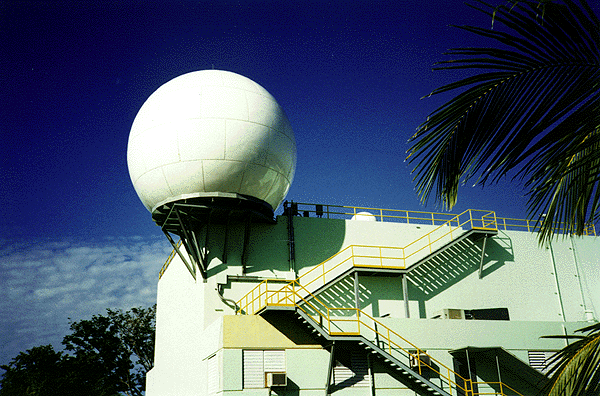

Mission Status Report #61 Star Date: Sept. 5, 2002
FUSE Primary Ground Station in Good ShapeCaption:This photo was taken July 11, 2002, during a site visit to the FUSE ground station at the University of Puerto Rico in Mayaguez by JHU personnel. The antenna in the background is slightly smaller than the FUSE antenna and is used for Landsat data downlinks. (The FUSE antenna is housed in a protective Radome and cannot be viewed directly.) (Photo courtesy Javier Diaz-Serrano, UPRM.) (Click image above to see larger version.)
Operations continue nominally on the FUSE project. We continue to "push the envelope" to understand better where we can operate in a stable configuration with the new control system installed last January, and can now get to targets over at least 75% of the sky at some time during the year. Recent progress has been made in utilizing "partially stable orbits" (where stability is lost for a short time during occultation or other times unusable for science operations), and it looks like using such orbits for science may be feasible. This will open up more observing windows on otherwise marginally observable targets. We are also shrinking down the size of the "Ram avoidance zone," a region near the plane of the FUSE orbit which is avoided to prevent potential damage to the FUSE mirrors. We have always used +/-20 degrees for this constraint, and it has now been reduced to +/-15 degrees. As we move closer to solar minimum, where the atmospheric density in our orbit decreases, we should be able to decrease the size of this zone even further, and thus open up even more of the sky for FUSE observations again. In July, four JHU personnel had the pleasure of making a visit to the site of our primary ground station antenna in Puerto Rico. The 5-meter antenna is located on the roof of the Tropical Center for Earth and Space Studies (TCESS) building at the University of Puerto Rico at Mayaguez (UPRM). TCESS maintains and operates several antennas for various projects, including the Landsat antenna pictured above and the FUSE antenna (below).

Caption:This photo shows the Radome in place over the FUSE ground station at the University of Puerto Rico in Mayaguez. The antenna can look right through the Radome and track FUSE across the sky as it passes overhead. (Photo from March 1999. Click image above to see larger version.) The FUSE antenna is housed in a Radome to protect it from severe weather.* This also permits the enclosure to be climate controlled, which has a very positive effect of condition of the antenna and the electronics. (The antenna itself looks like new!) A FUSE control center for the antenna, with computers and more electronics, is located in a room directly below the antenna on the second floor of the building. TCESS personnel provide us with excellent support, as was evident from a first-hand inspection of the facilities. For more pictures from this trip, follow THIS LINK. In other news, the NASA Cycle 4 Call for Proposals is out, with proposals for the next round of observing due by October 10, 2002. More information is available at the FUSE Guest Investigator Support Web Site [link no longer active]. Good luck to those who propose!
Reported by: Bill Blair, Chief of Observatory Operations
*FUSE Veterans may recall it was four years ago this September that the original FUSE ground station antenna was destroyed when hurricane Georges blasted through Puerto Rico, coming in from the southwest and directly into Mayaguez! Lucky for us, FUSE was not yet launched, and there was time to install an new antenna! But that is why extra steps were taken to protect this one!
|
